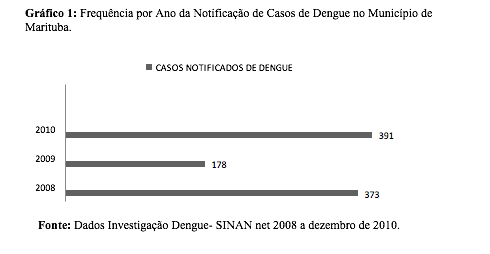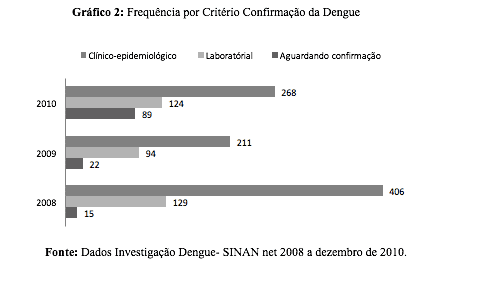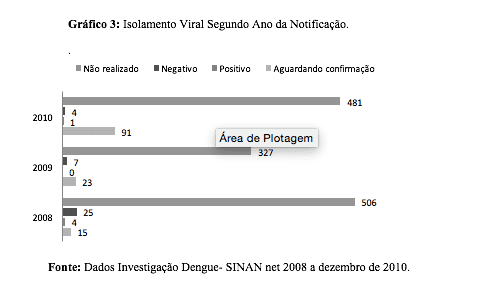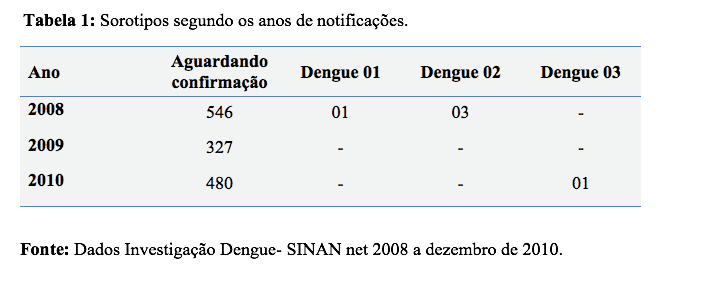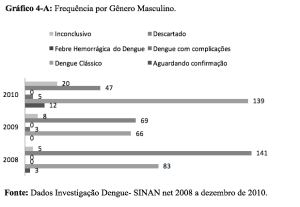FREITAS, Heldimar Soares de [1], FARIAS, Selma Ferreira de Freitas [2], FECURY, Amanda Alves [3], DIAS, Cláudio Alberto Gellis de Mattos [4],MOREIRA, Elizangela Claudia [5], OLIVEIRA, Euzébio de [6]
FREITAS, Heldimar Soares de. Et. al. Soroepidemiológica Analysis retrospective of dengue virus in the municipality of Marituba, PA-reported cases in the years 2008-2010. Multidisciplinary Core Scientific knowledge Magazine. Vol. 2, Year 01, Ed. 05, May of 2016, pp. 44-58-ISSN: 0959-2448
SUMMARY
Dengue is a disease transmitted by an arthropod that affects the human being, and constitutes a serious public health problem in Brazil and in the world. Disease caused by Dengue virus, of the genus Flavivirus. Are known in the world 4 dengue serotypes (1, 2, 3 and 4). The clinical picture is characterised by classical and haemorrhagic fever. This research sought to understand the epidemiology of the disease in the municipality of Marituba-metropolitan region of Belém-PA-Brazil, where data collection was conducted in the epidemiological surveillance of the municipality, for the years 2008-2010. The data show that the criteria for confirmation of diagnosis the disease (clinical, laboratory or epidemiological), was carried out by means of viral isolation serotype. He obtained a total of 942 cases for investigation of dengue, with the city seeking work with the confirmation through the clinical-epidemiological framework with greater proportion and a lesser amount for confirmation through laboratory examination. It was also found that the serotype 1, 2 and 3 are the most prevalent in the municipality and that the female gender is the most affected by the disease.
Key Words: Virus. Dengue fever. Soroepidemiologia. Bethlehem. Brazil.
INTRODUCTION
Daily communications vehicles, are circulating information expressing numerous episodes, which are considered of great importance for the population. One of the facts that are treated by the media, are those related to the problems in the area of public health, especially nowadays, one can cite the dengue fever. Since ancient times, the companies had an interest in establishing relationships between environmental factors and health, to prevent the occurrence and spread of new cases of diseases such as dengue (TEIXEIRA and BARRETO, 2008).
The municipality of Marituba is located in metropolitan region of Belém-Pará, integrating to the northeast of Bethlehem. Has a humid tropical climate, whose temperature during the year reaches on average 26 c. the hot months are between August and December. In this period the maximum average reaches 32° C and the minimum average reaches 22 C. The annual average rainfall reaches 2,500 mm. The relative humidity reaches 85% (SUDAM, 1984). The municipality of United, like other municipalities of Brazil, has the concern to prevent against dengue fever which is a disease that’s in the media throughout the country and that affects and that some cases kill more people each year, thus becoming a serious public health problem.
Dengue is an acute febrile illness, viral etiology known by an arbovirus of the Flavivirus genus and species of the family Flaviviridae. This genre has like scope 60 virus, twenty-one of which are pathogenic to human species. Immunologically four serotypes are known: Dengue, Dengue 1 2, 3 4 Dengue and Dengue. Benign evolution, in classic form, which is characterized, the symptoms presented by a fever, a breeze, muscle pains intensely mainly lumbar regions and legs, joint pain, headache, epigastric pain, nausea, vomiting, diarrhea, among others.
In the severe form of the disease early symptoms are similar to those of dengue fever. When you have the severe form-hemorrhagic in three to four days, begin to occur internal bleeding, blood pressure decreases, the lips turn purple, abdominal pain and alternate periods of lethargy and restlessness, and dengue hemorrhagic fever can take the infected individual to death (AMABYS, 2006).
Dengue is currently one of the most important diseases transmitted by arthropods, insects of the genus Aedes, that in Brazil the known species is the Aedes aegypti. There are others like Aedes albopictus and Aedes africanus which are secondary vectors of the Asian and African continents, affecting man and are serious public health problem in the world. In Brazil especially in tropical countries, where environmental conditions favour the development and proliferation of Aedes aegypti, this is the main vector.
This requires a large clarification to the population about the places where the insects use as breeding grounds, so that each person can contribute more actively in action, promotion and maintenance of their health and the collective (AB, 1998). To this end it is necessary to raise the flag as an alert against a possible outbreak of dengue fever, although the company has concern with the disease, there is still much to do, especially in counties that have an inadequate garbage collection system and lack of basic sanitation (DONALISIO; GLASSER, 2002).
Therefore the coordination of health surveillance in the State of Pará is making the prevention in municipalities where the disease appears more often. Based on these data, this study sought to describe the epidemiological aspects of dengue cases in the municipality of United, in the metropolitan region of Belém, in the State of Pará-Brazil, during the period from January 2008 to December 2010 where notification of the disease were detected, the form of confirmation of dengue, viral isolation and serotype, and still related with a comparison between male and female , where it was confirmed that the female gender is still the great target of the disease in relation to the male gender.
The dengue fever currently constitutes a serious public health problem, where the municipality of Marituba for being located in a region with tropical climate is conducive to favoritism and proliferation of Aedes aegypti, and insects that vector has importance factor the ability to live in both households and peridomicílios as in the rural areas, causing it to spread epidemics of dengue (VERONESI , 1991). Based on this information, the following problem: what epidemiological dengue cases in the municipality of Marituba, located in the metropolitan region of Belém?
Thus the main relevance of the project is to disseminate data on the epidemiology of dengue in the municipality of Marituba and contribute to the awareness of the population about the seriousness of cases of dengue fever in this area, raising awareness about the need for Government/society partnership to combat the spread of dengue fever in the city, seeking also to emphasize social responsibility , rescuing the citizenship to reflect on the responsibility for yourself and for your community, since this viral infection there is no specific medication only symptomatic treatment (FUNASA, 2002).
This project sought to carry out a survey of reported cases through the reportable diseases information system of notifications (SINAN) of patients with suspected dengue fever and later do a correlation with the disease cases surveyed in the municipality of Marituba through epidemiological surveillance sector of the municipality in the periods of January 2008 to December 2010.
In this context, this research had as general objective to conduct a soroepidemiológica retrospective analysis of dengue virus in the municipality of Marituba-Pará, Brazil, through the survey of reported cases in the years 2008-2010.
METHODOLOGY
The present work was carried out by means of bibliographical research in books, magazines, and scientific articles in a row of field research on the epidemiology of dengue in the municipality of Marituba, para. It was held also a study with variables: spatial, temporal, distribution of the disease and insect infestation index transmitter (Aedes aegypti).
Obtaining field data occurred in the months of August to December 2012, in the epidemiological surveillance of the municipality of Marituba, by SINAN, with analysis of dengue research, covering the period from January 2008 to December 2010. It is noteworthy that the study period (2008-2010), occurred on the fact of all the data in this study investigated about dengue, are already available for research, as well as notified in SINAN. On the research on dengue fever was done an epidemiological study in the municipality of United, to sensitize society about dengue fever and prevent an outbreak in the city since the population is unaware of the severity of the disease.
RESULTS AND DISCUSSION
The municipality of Marituba is located in metropolitan region of Belém-Pará, integrating to the northeast of Bethlehem. “This municipality has the smallest territorial extension of the State of Pará, with 109.10 km its geographic coordinate: 01° 21 ‘ 15” longitude West of Greenwich (IDESP, 2009). Has a humid tropical climate, whose temperature during the year reaches on average 26 cº, the hot months are between August and December. In this period the maximum average reaches 32 c and the minimum average reaches 22 C°, the annual average rainfall reaches 2,500 mm. The relative humidity reaches 85% (SUDAM, 1984).
The rains are not equally throughout the year and offers a higher incidence in the months of January to June. While the hottest period coincides with lower intensity of rain.
The municipality of Marituba has approximately a population of 101.158 inhabitants (IBGE, 2009) divided into neighborhoods and towns that add up to 30.
This research had as main focus assess the dengue data inserted in SINAN in January 2008 to December 2010, to understand the aggravation of the disease profile, in the municipality of United.
The data relating to cases notified in SINAN (graph 1) were obtained with the epidemiological surveillance Sector of the municipality of United. Were notified during the three years of data collected, the information of 942 cases for investigation of dengue fever in the whole municipality.
The Type1, in the year 2008 were investigated in the districts of Marituba, 373 cases of dengue notifications being that in the year 2009 this index decreased to 178, however, there was no public policies for this reduction and Yes factors that caused the lack of notification in the health units, as due to lack communication between health professionals to do the job against dengue.
Already in the year 2010, the number of cases jumped to 391, where the major concern occurred in the sense of the data they represent only outbreaks in the neighborhoods that comprise the municipality, to occur a endemic disease. What second Ab (1998). This is a progressive process that needs to have this notification of suspected cases of dengue fever in health units in the duration of outbreaks, to occur so the epidemiological investigations properly, because if not taken steps of planning and implementation of measures to control the disease cases geographical population becomes vulnerable to dengue epidemic.
The incidence of cases of dengue fever in the districts of the municipality of Marituba occurs often due to lack of awareness of their own population as well as by lack of sanitation offered by municipal and State Government. This reflects the fact that the municipality of Marituba have arisen recently, since the same was founded in 1994, where he spent the condition of Ananindeua district to municipality in the State of Pará (GRANHEN, 2002).
The diagnosis of dengue fever cases in the municipality of Marituba is made according to two criteria for confirmation: a clinical-epidemiological and other laboratory. Chart 2 shows the investigation of cases of dengue fever in the city of United.
In January 2008, to December 2010, in the sample of data collected in the municipality of dengue, there was a total of 1358 to confirm cases of the disease. The graph pointed out that in 2008, 550 cases have been reported for confirmation criterion, and 15 samples are awaiting confirmation, 129 cases confirmed by laboratory for dengue and 406 clinical-epidemiological confirmation.
In 2009 there were 327 confirmations, with 22 awaiting confirmation, 94 confirmed in laboratory and clinical-epidemiological confirmation with 211. A significant reduction compared to the previous year (2008), however in 2010 the Board back up to 481 cases for confirmation, and by December 2010 89 cases of notification are still waiting for confirmation, 124 confirmed through laboratory and clinical-epidemiological confirmation with 268.
The laboratory confirmation teeters on average for the preceding three years, 2008, 2009, 94 129 confirmations, confirmations and 2010 with 124 acknowledgments. The more worrying dengue research for confirmation criterion is ignored and white, where during the year 2008, 2009 and 2010, are still awaiting laboratory confirmation. That is, information that the laboratory will hardly provide for epidemiological surveillance of the municipality of United. These serological tests are the simplest and fastest way to confirmation of a clinical suspicion. However, the interpretation of your results can, in most cases, encounter some problems (VERONESI, 1991).
Lion (1997) reports that the laboratory diagnosis is of fundamental importance in specific areas without vector transmission, and also in areas with established transmission, but with a few cases, where should be laboratory confirmed. With the presence of cases where the clinical and epidemiological diagnosis, the lab is also present, however in situations where cases worsen to identify type of the disease.
The clinical and epidemiological framework is the quick way to diagnose the disease, since the confirmation of the symptom of dengue fever in the area where a notification is made through laboratory tests or in area where the vector found by epidemiological surveillance and give the name of epidemiological link is when the symptoms of dengue fever are reported in a patient where in the area the vector settles (FUNASA , 2005).
Viral isolation is the ideal method for the determination of specific arbovirus, responsible for infection. Whole blood, serum, plasma, or blood clot are the materials of choice for isolation attempts (FACCACIO, 2010).
According to the chart 3 the collection to the viral isolation in January 2008, until December 2010, presented a total of 1358 cases for diagnosis of dengue. However in 2008, only 04 cases were confirmed for dengue, 25 were discarded; 15 waiting for confirmation and 506 were not realized, because the cases have been confirmed with clinical-epidemiological.
Already in 2009 the total of 327 cases for confirmation, there was no positive confirmation for any case; 07 cases had negative acknowledgment for dengue and 23 waiting for confirmations. What we emphasize is that the total of 397 cases, 297 were not conducted laboratory tests. In 2010, was retrieved from a total of 481 cases for confirmation, and there was only one confirmed case for viral isolation; 04 negative cases and 85 cases were not conducted the tests.
Due to the great demand for confirmation of disease, not all patients have the diagnosis confirmed by viral isolation to detect that serotype circulating in the municipality. The clinical epidemiological factor is most often used, because it is quickly the disease and the epidemiological surveillance does work in areas where awareness has a higher concentration of the vector and sick patient cases in these areas. For Vasconcelos (2000). The most plausible explanation for this fact to diagnose through epidemiological clinical is the attendance and the active search for cases of dengue fever in the town, which in turn makes it possible to find the largest number of disabled people with the disease.
01 table shows the circulating serotypes of the dengue virus in the municipality of Marituba, according to laboratory tests carried out:
As you can see, with the laboratory information, it was found that the serotypes that have circulated in the city in 2008, were the serotypes 1 and 2. These data were obtained through the laboratory testing of the 550 people who showed symptoms of dengue, and this year (2008), serotype confirmation occurred only in one person for DEN 1 and three for DEN 2, 546 people are still awaiting the completion of the tests for identifying the serotype or clinical data were enough to close epidemiological diagnosis. In the year of 2009, were obtidas327 samples for verification of serotypes of dengue, there has been no confirmation of serotype, in the year 2010, of the samples, only 481 01 was confirmed with the serotype and 480 DEN3 await response from the results of the tests that are being conducted by the Central Laboratory of the State of Pará (LACEN).
This delay for confirmation of serotype, hardly will have results completed, because of the time that were made, with collections that can be a major concern for the population of the municipality of United. For Teixeira (1999) reports that the dengue virus can change its epidemic potential and also their clinical presentations when moving between populations. When dengue affects society she doesn’t know the gender of the individual. 4 graphics-and 4-B, below, show the frequency of involvement by dengue in relation to male and female gender in the municipality of Marituba periods of analysis of this research.
Noting the graphics 4-A and 4-B, in relation to the gender of the patients served by SINAN in the years 2008 to 2010, 1358 were recorded notifications for dengue, and year of 2008, the 550 people notified, 232 were male, showing 03 cases to wait to be notified; 83 confirmed cases for classic dengue; 141 discarded for dengue and 05 inconclusive. To the female in the year 2008, 318 cases were reported, with 04 cases are awaiting laboratory confirmation; 137 cases of classic dengue; 01 case with complications; 173 cases discarded for dengue and 06 cases inconclusive.
In the year of 2009 of 327 cases reported 01 case was dropped due to lack of proper fill plug for the SINAN, thus not declared the sex of the patient. That year the males 146 cases have been reported, and of those, 66 were confirmed for classic dengue; 03 confirmations for dengue fever with complications; 69 were discarded for disease and 08 inconclusive. For the 180 female reported cases, being 64 confirmed for classic dengue; 02 for dengue cases with complications; 100 cases for discarded for dengue and 14 inconclusive.
And the year 2010, 481 cases were recorded in total, being for the male 223 cases registered. Of these 12 are waiting for confirmation; 139 confirmed cases for classic dengue; 05 confirmed cases for dengue fever with complications; discarded and 20 47 inconclusive. Females were 258 cases registered for dengue, where 130 for classic dengue; 07 dengue cases with complications; 01 case of death as a result of dengue hemorrhagic fever; 63 discarded for dengue and 39 inconclusive.
It is worth mentioning that the graph points out the largest number of reported cases in people female, and according to data from literature that is due to women’s clothing, because the mosquito vector is preferred by sugar mainly in feet or in the lower parts of the legs, however that doesn’t mean that these insects cannot suck up other parts of the human body and to animals (NEVES , 2003).
What can be seen also with these data is that the male, despite reported cases being outnumbered in relation to female, present the disease classically, and this is due to the man purchased the first serotype due to some factors, such as work outside the place of his domicile and, by wearing clothing that make the bite of insects. In the female the concern is greater, because due to transmission occur more at home and peridomestic habitats, the risk of acquiring dengue is greater in women who make up the groups that remain longer at his residence (Lion, 1997).
It is important to note also that in the medical records of dengue research, wrong search monitoring damages unfortunately, because present inconclusive data and/or research still conclude from January 2008 to December 2010.
Therefore, it is necessary to emphasize that these annual reviews of the clinical and epidemiological data of dengue are fundamental to the development and implementation of public health programmes, in order to better combat the disease through educational and preventive measures members in the County studied. But for this to happen it is extremely important that the data be collected correctly to the actual knowledge of the behavior of the injury and the profile of the patient, thus contributing to effective planning for the control of dengue fever in the city.
CONCLUSION
Dengue is one of the main public health problems across the country, and this is due to its easy expansion and a potential for serious and even fatal cases (PAHO, 1991). The results obtained with the implementation of the present research underline the need for more effective prevention in the municipality of Marituba, mainly in relation to the vector of the disease, since it is already known that the registry index of dengue during the years surveyed (2008-2010) showed considerable in terms of public health.
This is demonstrated by the more confirmation criterion used in the municipality, which is the confirmation by means of clinical-epidemiological, supported by viral isolation tests carried out in laboratories, trained to detect circulating serotype in this region. The comparison of the involvement of the disease in relation to sex also requires attention, since women are more affected, because they are more subject to the attack vector. In this sense should also exist public health programmes geared to this genre, as better guidance about environmental care that must be adopted in the home.
To understand the epidemiological situation that is worrying in the municipality of United, it is necessary to be a linkage between the three levels of Government (municipal, State and federal), along with the community itself, with permanent control of this disease. Since the advancement of dengue is generated by a static society, is that we should sensitize the population so that there is a collective combat, especially with more effectiveness.
In the municipality of Marituba the difficulty in controlling the proliferation of vector occurs due to basic sanitation conditions and the high concentration of the population in the peripheral area. For this it is necessary to maintain continuously educational activities to clarify the population about the disease and combating vector (GONÇALVES NETO et. Al, 2004).
Therefore, in the municipality of Marituba notifications are still a serious problem that must be corrected, once for lack of some incomplete information regarding notifications of SINAN on dengue fever, serious health problems for the population. The municipality have to do hard work to raise awareness of how cleanup actions in the city to eliminate insect focus, guide healthcare professionals to quickly and effectively diagnose the disease and also lectures in communities to prevent and combat the dengue mosquito. With these actions the population learns to be aware of symptoms of the disease and give also the allowance clarification to prevent against the Aedes aegypti mosquito.
REFERENCES
AGUIAR, Adriana Chandra. Epidemiological surveillance Support text. Publisher: yarn cross, 1998.
AMABIS, José Mariano. Foundations of modern biology. 4th Edition, Publisher, 2006.
BOSCHILIA, Cleusa. Mini dictionary, compact of biology. 2nd Edition. Ed. Rideel, 2003.
BRAGA, Ima Aggarwal; Valle, Denise. Aedes aegypti: history of control in Brazil. 2007.
Brazil. Ministry of health. National Health Foundation, Dengue: epidemiological Aspects, diagnosis and treatment, 2002.
Brazil. Ministry of health. National Foundation of health, Epidemiological Bulletin, 1999.
BRAZIL, Geraldo Son. Pathology. 7th Edition, Ed. Guanabara. Year 2006.
DONALÍSIO, Maria Rita, GLASSER, Carmen Moreno. Entomological surveillance and control of vectors of Dengue. Brazilian Journal of epidemiology. Vol. 5, no. 3, 2002 year.
FACACCIO, Roberto. In the case of infectious diseases, vol. 1, Atheu Publishing House, 2010.
GAUTAM NAIK, VS, Rahaman JMM. Epidemiological aspects of dengue fever in the city of São Luis Maranhão, Brazil, 1997-2002. CAD. Public health, 2004.
GRANHEN, Jorge. The true story of United. Year 2002.
GUZMAN, M.G. et al. Dengue in Cuba, 1991: retrospectivesero epidemiologic study. American journal of tropical medicine and hygiene. Lawrence, v. 42, no. 2, 1990 year.
IDESP-Institute of economic development, Social and environmental development of para-Municipal statistical Marituba. Year 2009.
Lion, Raimundo Nonato Queiroz. Infectious and parasitic diseases-Amazonian Approach, Publisher Cejup, 1997.
LEVINSON, Warren and JANETZ, Ernest. Microbiology. Editing. 07. Publisher: New Haven, 2005.
LOYOLA, Carlos Prates Pratão. Dengue in the Americas. Symposium on dengue. University of São Paulo. College of public health. 2000. p. 48-56.
Ministry of health (BR). Dengue: Pathophysiology and clinical picture. FUNASA, 2005.
MONATH TP & HEINZ F. Flaviviruses. In: FIELDS BN; KNIPE DM, HOWLEY PM &, eds. Virology, Lippincott-Raven, Philadelphia, p. 961-1034, 1996.
SNOW, David Parker. Human parasitology, Publisher Atheneu 10 Edition. 2003
OLIVEIRA, Alexandre R. Dayal. Publisher. Biology and health, Rio de Janeiro, 2000.
PAN AMERICAN HEALTH ORGANIZATION. Guidelines on the prevention and control of dengue and dengue hemorrhagic fever in the Americas. 1991. Meeting report on guidelines for Dengue.
SOARES, José Luís, health program, Editora Scipione, 2nd Edition, 1994.
Teixeira, Maria da Glória; BARRETO, Mauricio Lima; WAR, Zouraide. Epidemiology and prevention of Dengue fever. 1999, vol. 8, no. 4.
Teixeira, Maria da Glória; BARRETO, Mauricio Lima. Dengue fever in Brazil: epidemiological situation and contributions to a research agenda. Study. AV. Vol. 22 No. 64, São Paulo. Dec. 2008
Richard TRABULSI, Luiz. Microbiology. Editing. 05. São Paulo. Publisher Atheneu, 2008.
Vasconcelos, Pedro Fernando da Costa ET al. Epidemic of dengue fever in Ipupiara and Prado, Bahia. Sero-epidemiological survey. Journal of the Brazilian Society of Tropical Medicine. Year. 2000.
VERONESI, Ricardo; Infectious and parasitic diseases. Ed. 08. Editora Guanabara Koogan, 1991-.
[1] Biologist. Specialist in microbiology from the College Ipiranga, PA.
[2] Metropolitan College Studen from Amazon.
[3] Doctorate in Tropical Diseases. Lecturer and researcher at the Federal University of Amapá, AP. A researcher at the Graduate program of the Center for Tropical Medicine of the UFPA.
[4] Biologist, Doctor in theory and research. Lecturer and researcher at the Federal Institute of Amapá-IFAP.
[5] Psychologist. Master in theory and research. Lecturer at the University of the State of Pará-UEPA. A researcher at the Graduate program of the Center for Tropical Medicine of the UFPA.
[6] Biologist. Doctor of medicine/Tropical Diseases. Lecturer and researcher at the Federal University of Pará – UFPA. A researcher at the Graduate program of the Center for Tropical Medicine UFPA.
